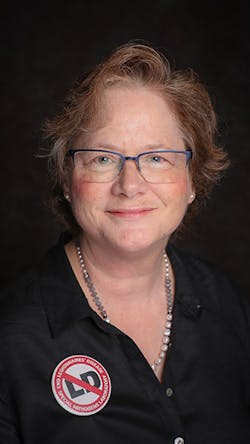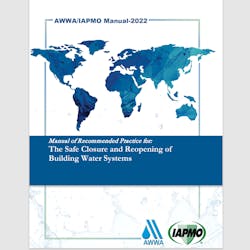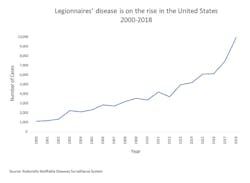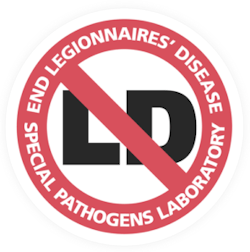HPAC 'On The Air': Legionella Update with Dr. Janet Stout
In this episode, HPAC 'On the Air' welcomes Dr. Janet E. Stout, executive vice president and founder of the Special Pathogens Laboratory and an associate professor at the University of Pittsburgh Swanson School of Engineering.
An infectious disease microbiologist, Dr. Stout is recognized worldwide for her pioneering research in Legionella and now, after three decades, remains on a mission to End Legionnaires’ disease. She updates us here on where that mission is today...
What follows is an edited transcript of our conversation, recorded in June...
HPAC: Our topic this month is Legionella, the notorious bacteria first detected in a hotel water system at the American Legion Convention in Philadelphia in 1976. That outbreak sickened over 200 attendees, killed 34 and spawned decades of new research, scrutiny and remedial strategies for building engineers worldwide.
Our guest today is one of the world's foremost experts on the subject, Dr. Janet Stout, whose expertise includes detection, prevention, and control strategies for Legionnaire's disease in building water systems. She advances the mission to End Legionnaires’ disease by speaking and serving on numerous industry committees, including those for ASHRAE Legionella standard SSPC 188, Guideline 12-2020, and Proposed Standard 514. Dr. Stout, welcome to HPAC 'On The Air'.
Dr. Janet Stout: Thank you so much, Robert. It's a pleasure to be with you and your audience.
HPAC: Please tell our listeners a bit more about your background, your current work, and how you came to study this subject for nearly 40 years now.
Dr. Stout: Well, I say I'm an infectious disease microbiologist who has studied Legionella for more than 30 years. I refuse to say 40. That makes me sound too old. Of course, when a microbiologist studies Legionella for their entire career, they are not a microbiologist anymore. So, I'm a "legionellologist." And yes, I did make that up. But I think it adequately describes my career. And it all started when I got my master's degree at the Graduate School of Public Health in 1982, studying Legionella. And there was an outbreak of Legionnaire's Disease then at the Pittsburgh VA Medical Center. I had the good fortune to be doing my master's work there. And Legionella and I have been together ever since.
HPAC: Just so we are all on the same page here, could you please define Legionnaires' Disease and talk about its origins? Is it exclusively something connected to the arrival of HVAC in society? If so, was there evidence of it in the decades prior to the Legionnaires' convention in '76?
Dr. Stout: So, I love telling the story about Legionella. At the American Legion Convention in 1976, they deduced that Legionella was coming from the air conditioning system because the epidemiologist had studied who got Legionnaire's disease and who didn't.
Most of the people who got it were in Ballroom A. So, the only way to transmit it must have been through the air. But what we learned later, in 1982, we published in a seminal article in the New England Journal of Medicine. It said that in our VA hospital (in Pittsburgh), it wasn't coming through the air ducts. It was coming out of the faucets in the showers and infecting the veterans there from the potable water distribution system.
So back in 1976, Legionella was not a new bacteria, per se. It was a newly discovered bacterium. And the reason is because this bacteria requires a very specialized culture, media to grow it, which was developed as a result of that outbreak.
Investigators at the Center for Disease Control and Prevention (CDC) formulated a brand new media. Then when they were able to grow the bacteria, they went back to their freezers for unsolved mysterious cases of pneumonia. And they found a type of Legionella going back to 1947 that had caused pneumonia in a patient. Then they also saw some that were from the 1950s, and so forth. So that's how we know it existed prior to 1976.
And to your point, we also have these man-made systems that provide Legionella bacteria with just the right conditions to grow -- which is nice, warm water, some organic material in our piping systems, our cooling towers and such, and hot tubs. Don't get me started on hot tubs! But that creates a great environment for Legionella and other bacteria to grow. So, what I say is that what's happening in those pipes is that "Legionella is having a party in the pipes."
HPAC: As I understand it, stagnant building systems circulating air and water have long been seen as the key contributing factor to the development of Legionella. So, in the wake of building shutdowns globally for the Covid pandemic over the last three years, how much has that led to a resurgence of Legionnaires' today?
Dr. Stout: Well, I'm a 'glass half-full' person. So, the good news was that in 2020, we knew that Legionella was in these buildings and their water distribution systems, and that closures, shutdowns, and stagnation would provide that great environment for Legionella and its friends to grow. And so that meant that there was a much greater awareness about it. We said, "Okay, let's not just let this happen; let's do things to mitigate the risk."
And in fact, in 2020, the American Water Works Association (AWWA) and the International Association of Plumbing and Mechanical Officials (IAPMO) wrote a white paper on responding to water stagnation in buildings with reduced or no water use. That was their answer to helping people to manage the fact that building shutdowns impact water quality. For instance, cold water warms up and warm water cools down into that sweet spot for Legionella to grow. And any disinfectant that was there is gone because of water age and just sort of sitting there.
So, they had a program for that they described there, and they actually just updated it in January 2023. Your readers can look for the AWWA/IAPMO Manual-2022: Manual of Recommended Practices for the Safe Closure and Reopening of Building Water Systems. Those documents are free. So, they can go online and download them. And so we knew that there was a potential problem.
Did we have lots of outbreaks of Legionnaires' Disease during the pandemic?
Certainly, we had cases, and sometimes they actually got confused with the diagnosis of Covid because they present so similarly in terms of pneumonia. But actually, what happened was the number of (LD) cases nationally went down. After all, everybody's wearing masks, nobody's going out, etc., so that was interesting. We actually presented that information at the National Infection Prevention Conference a couple of years ago, that during the Covid pandemic, cases actually went down. But we're returning back to baseline now. Because the problems persist, which is very frustrating for a 'legionellologist.' But we can talk about that 'til the cows come home.
HPAC: And ASHRAE also just developed its first-ever pathogen mitigation standard for infectious aerosols. It recommends several HVAC-related measures to reduce the risk of transmission of Covid-19, influenza, and other airborne viruses and homes, offices and hospitals, etc. Once adopted this summer, will those measures also help in the renewed fight against Legionnaires' Disease?
Dr. Stout: Anything that improves air quality has the potential of mitigating risk from anything that may be transmitted through the air. So, I applaud ASHRAE, and because I've been on these committees myself, I know they work long and hard to get across that finish line. But the thing about Legionella is that we need to stop it before it ever gets into the HVAC system, because it's in the water.
If we control this bacteria in the water, prevent its replication, then we can prevent the disease entirely. So this is part of the reason why we have this mission to end Legionnaires' Disease. Because no one needs to become infected with this bacteria if we control it in the water. So what ASHRAE had done, and I was first invited to sit on an ASHRAE committee back in 1995, I think, when they were first working on Guideline 12. That was then published in 2000.
And then that morphed into Standard 188, which is a paradigm of water management, recognizing the risk, assessing the risk, both in the potable water system, as well as in devices like cooling towers, hot tubs and spas and decorative water features -- places where we know outbreaks have occurred -- and then address that risk directly. The most recent work that ASHRAE has done, and I'm also on that committee for Proposed Standard 514, is about managing the risk of physical, chemical and microbial hazards. So, these are other bacteria that are in water, particularly in hospital water systems that can cause infection.
And just because it's fun, I'm going to tell you a few of the names of these other pathogens. My favorite is "Stenotrophomonas maltophilia." I always say I feel like I should be doing a line dance when I say that. Others
Yes. But most of us don't have to worry too much about it. It's people that have compromising health conditions, particularly if they're hospitalized, that can become a problem. And so ASHRAE felt that the water management approach should be applied to these other bacteria. But the problem is that they're also transmitted in other ways than just exposure to the water.
For instance, they can be transmitted on the hands of healthcare workers, on surfaces, and things like that. So, their prevention is a little more complicated than for Legionella, where it's just in the water. So, if we control the water, we control the disease.
HPAC: Overall, where do you think we are now on that spectrum of actually controlling Legionnaire's Disease? How would you say the fight is going? You say that you are on a mission to end the disease. Do you think that is something that can be accomplished in our lifetime?
Dr. Stout: Yes. So, you know, some of your listeners might have read some of the popular books by Jim Collins. In one of his books, Successful Habits of Visionary Companies, he talks about setting BHAG's, which stands for "Big, Hairy, Audacious Goals." For me, ending Legionnaires' Disease is that "big, hairy, audacious goal." But I say it's not so much audacious, as achievable. As we get people to test for Legionella in their water systems, if they find it, particularly the type that causes a lot of infection, Legionella pneumophila 1, then they can prevent it. They can control it. I just wrote a piece in May for Plumbing and Mechanical Engineer magazine where I talked about how we can end Legionnaire's Disease with smart plumbing design.
HPAC: When you say half are, do you mean that half are susceptible? Or that half already have it?
Dr. Stout: Half are colonized. They have Legionella in their water systems. Half do not. One of the myths about Legionella is that it's everywhere, or ubiquitous. It is not everywhere. And our studies and other people's studies have shown that when you go out and you look at buildings in a large metropolitan city, whether it's a hospital or a high-rise building, the rule of thumb and the results show that about half have legionella in them.
And so there's risk there that can be mitigated and disease prevented. And one of the points that I wanted to make about this disease -- which is a very serious form of pneumonia -- is that if someone goes into the hospital for some other reason, and that hospital has Legionella in its water and it has not mitigated, and they get Legionnaires' Disease, the risk of death from that pneumonia is 25 to 30%. That is huge.
And so that's why the emphasis has to be on prevention. Because once somebody becomes infected, it's a downhill spiral of inflammation, even if they get the right antibiotic. They're trying to control the inflammation in the lungs, and they get adult respiratory distress syndrome, and 25 to 30% of them die. It's completely unnecessary.
HPAC: Do you feel like there is the necessary commitment there from government and building owners to attack this problem on the level that you're suggesting that it needs to be on?
Dr. Stout: So, there is awareness. But as you know, oftentimes, people don't take the next step to execute a water management plan. For example, they say that ASHRAE Standard 188 is a voluntary standard. "So, I don't have to. It has not yet been incorporated into the code." People think it will never happen to them.
So, I say, "Legionella is the problem that you don't think you have until you have it. And then it's an emergency, and the health department's knocking at your door. Now you have to implement disinfection procedures in the next 48 hours. You have to have a sampling plan. The health department's going to be very unhappy with you."
All of that you need to be prepared for. Facility engineers know about preparation, i.e. fire preparation, electrical outages, etc. Well, they should think about preparing for a Legionella emergency, too. By having all the vendors approved for disinfection, for bottled water, for point-of-use filters, all of these things that need to be implemented. Find your consultant, because the health department will tell you to get one. Because the health department recognizes that this is specialized knowledge that people on site may not have..
HPAC: Good to know. Thank you for sharing. As a matter of fact, I think I do have more Legionella-related anxiety now than when we started. But this is not exclusively a U.S. problem, is it? So where are we globally now in the fight to end Legionnaires' Disease?
Dr. Stout: You're absolutely right. For many years, other countries across the world have been far ahead of the U.S. in mandating testing in control of Legionella, in water systems of hospitals and cooling towers. Places like Spain, France, Germany, the Netherlands, Australia, etc. So when we came out with our guidance document, Standard 188-2015, I was like, "Finally, the United States is catching up with the rest of the world."
But we still fall short of the rest of the world because the rest of the world says "test." They actually require a certain frequency of testing in almost all of those countries. And Legionnaires' Disease is on the rise, both in the United States and across the globe. People speculate about the causes for that.
Certainly, the warming of the planet creates a nicer environment for Legionella in our source waters. We're aging and so many people in the population have those diseases that increase risk like diabetes and cancer and chronic lung disease, and they're on steroids.
Aging infrastructure is also something that the CDC has talked about as contributing possibly to the increase in LD cases. So, Legionella is on the rise, which does make this 'legionellologist' a little depressed. But as I said, I'm also a glass-half-full person. So, if we can get everyone to have a water management plan and then to do testing as part of that plan, then we're moving in the right direction.
In fact, a water management plan and risk assessment are now mandated for hospitals through the Center for Medicare & Medicaid Services in the Joint Commission, which just came out with its new Environment of Care standards in January 2022. So, as I said, we are going in the right direction, Rob.
In terms of our mission to end Legionnaires' Disease, ASSE also has a Standard 12080, which is a professional qualification standard for people doing water management. And that 24-hour training is delivered through our Special Pathogens Lab and IAPMO, and the next training to be certified as a water management specialist is actually July 31st. It's a three-day training session. You can get more information about that, as well as future sessions. And if you want more education about Legionella, we also do a Wednesday webinar series where you can learn more at puzzledbylegionella.com.
HPAC: Dr. Stout, thanks so much for your time here. Somehow this was both alarming and hopeful. We certainly wish you continued success on your mission to end Legionnaires' Disease.
Dr. Stout: You're welcome, Rob. Thanks for letting me speak to your audience. And don't forget, anyone can e-mail me for their own bottle of Chill Pills at [email protected]. Thanks again!
############
Additional links for some key items mentioned in this podcast:
Stagnation
Manual of Recommended Practices for Safe Closure and Reopening of Building Water Systems
https://www.iapmo.org/media/31196/awwa-iapmo-manual-2022.pdf
Education
Get certified as a Legionella Water Safety and Management Specialist!
https://puzzledbylegionella.com/
Puzzled By Legionella, Wednesday Webinar Series
https://specialpathogenstechnology.com/puzzled-by-legionella/
Legionella and Waterborne Pathogen Testing
https://specialpathogenslab.com/
##########
To listen to previous 'HPAC On The Air' podcasts, please visit our Members Only page.
About the Author
Rob McManamy
Editor in Chief
An industry reporter and editor since 1987, McManamy joined HPAC Engineering in September 2017, after three years with BuiltWorlds.com, a Chicago-based media startup focused on tech innovation in the built environment. He has been covering design and construction issues for more than 30 years, having started at Engineering News-Record (ENR) in New York, before becoming its Midwest Bureau Chief in 1990. In 1998, McManamy was named Editor-in-Chief of Design-Build magazine, where he served for four years. He subsequently worked as an editor and freelance writer for Building Design + Construction and Public Works magazines.
A native of Bronx, NY, he is a graduate of both the University of Virginia, and The John Marshall Law School in Chicago.
Contact him at [email protected].





